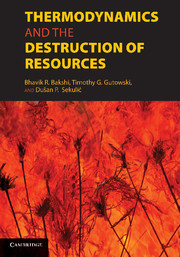Book contents
- Frontmatter
- Contents
- Contributor List
- Foreword by Herman E. Daly
- Foreword by Jan Szargut
- Preface
- Introduction
- PART I FOUNDATIONS
- PART II PRODUCTS AND PROCESSES
- PART III LIFE-CYCLE ASSESSMENTS AND METRICS
- 9 Using Thermodynamics and Statistics to Improve the Quality of Life-Cycle Inventory Data
- 10 Developing Sustainable Technology: Metrics From Thermodynamics
- 11 Entropy Production and Resource Consumption in Life-Cycle Assessments
- 12 Exergy and Material Flow in Industrial and Ecological Systems
- 13 Synthesis of Material Flow Analysis and Input–Output Analysis
- PART IV ECONOMIC SYSTEMS, SOCIAL SYSTEMS, INDUSTRIAL SYSTEMS, AND ECOSYSTEMS
- Appendix: Standard Chemical Exergy
- Index
- References
12 - Exergy and Material Flow in Industrial and Ecological Systems
Published online by Cambridge University Press: 01 June 2011
- Frontmatter
- Contents
- Contributor List
- Foreword by Herman E. Daly
- Foreword by Jan Szargut
- Preface
- Introduction
- PART I FOUNDATIONS
- PART II PRODUCTS AND PROCESSES
- PART III LIFE-CYCLE ASSESSMENTS AND METRICS
- 9 Using Thermodynamics and Statistics to Improve the Quality of Life-Cycle Inventory Data
- 10 Developing Sustainable Technology: Metrics From Thermodynamics
- 11 Entropy Production and Resource Consumption in Life-Cycle Assessments
- 12 Exergy and Material Flow in Industrial and Ecological Systems
- 13 Synthesis of Material Flow Analysis and Input–Output Analysis
- PART IV ECONOMIC SYSTEMS, SOCIAL SYSTEMS, INDUSTRIAL SYSTEMS, AND ECOSYSTEMS
- Appendix: Standard Chemical Exergy
- Index
- References
Summary
Introduction
Ecological resources constitute the basic support system for all activity on Earth. These resources include products such as air, water, minerals, and crude oil, and services such as carbon sequestration and pollution dissipation [1–4]. However, traditional methods in engineering and economics often fail to account for the contribution of ecosystems despite their obvious importance. The focus of these methods tends to be on short-term economic goals, whereas long-term sustainability issues get shortchanged. Such ignorance of ecosystems is widely believed to be one of the root causes behind a significant and alarming deterioration of global ecological resources [5–8].
Several methods have been developed to address the shortcomings of existing methods and to make them ecologically more conscious [9]. Among these, the preference-based methods use human valuation to account for ecosystem resources [3, 10, 11]. These methods use either a single monetary unit to readily compare economic and ecological contributions or multicriteria decision making to address trade-offs between indicators in completely different units. However, preference-based methods do not necessitate compliance with basic biophysical laws that all systems must satisfy and require knowledge about the role of ecological products and services that is often inadequate or unavailable.
- Type
- Chapter
- Information
- Thermodynamics and the Destruction of Resources , pp. 292 - 333Publisher: Cambridge University PressPrint publication year: 2011
References
- 1
- Cited by

